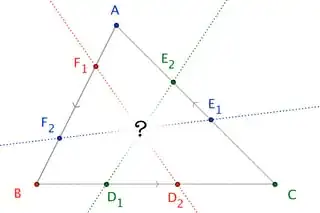Here is a "synthetic" solution with metric arguments:
We will show both conditions are equivalent with $\cos B +\cos C=\cos A$.
Condition 1: $O$ lies on $MN$. Let $\delta (P, XY)$ be the distance from point $P$ to line $XY$. Notice that since $M,N$ are the feet of the angle bisectors that $\delta (M, AB) + \delta (M, AC) = \delta (M, AB) = \delta (M, BC)$.
Meanwhile, $\delta (N, AB)+\delta (N,AC) = \delta (N,AC)=\delta (N,BC)$.
Since distances from points to lines form linear functions, the function $\delta (P, AB)+\delta (P, AC)-\delta (P, BC)$ must be zero for any point $P\in MN$, because it is zero for $P=M,N$.
Then if $O$ lies on the line, $\delta (P, BC)= R\cos A, \delta (P, AC)=R \cos B, \delta (P, AB)=R\cos C$ which implies $\cos B+\cos C=\cos A$.
Condition 2: $I$ lies on $EF$.
Remark that quadrilateral $BCEF$ is cyclic. Let $X$ be a point on segment $EF$ with $BF=XF$. Note that $\angle BXF = 0.5( \angle BXF + \angle FBX) = 0.5(\angle AFX) = 0.5 \angle ACB = \angle ICB$. This implies that quadrilateral $BXIC$ is cyclic.
As a result, since $\angle IBC=0.5\angle B$, we deduce $\angle IXC = 0.5\angle B$. Then since $\angle XEC = 180-\angle AEF = 180-\angle B$, we deduce that $\triangle XEC$ is isosceles so $XE=EC$.
Then $EF = EX+FX = EC+BF$. But $EF=a \cos A, EC = a \cos C, BF = a \cos B$ so we deduce $\cos A =\cos B + \cos C$ as desired.
Thus the two conditions are equivalent.

